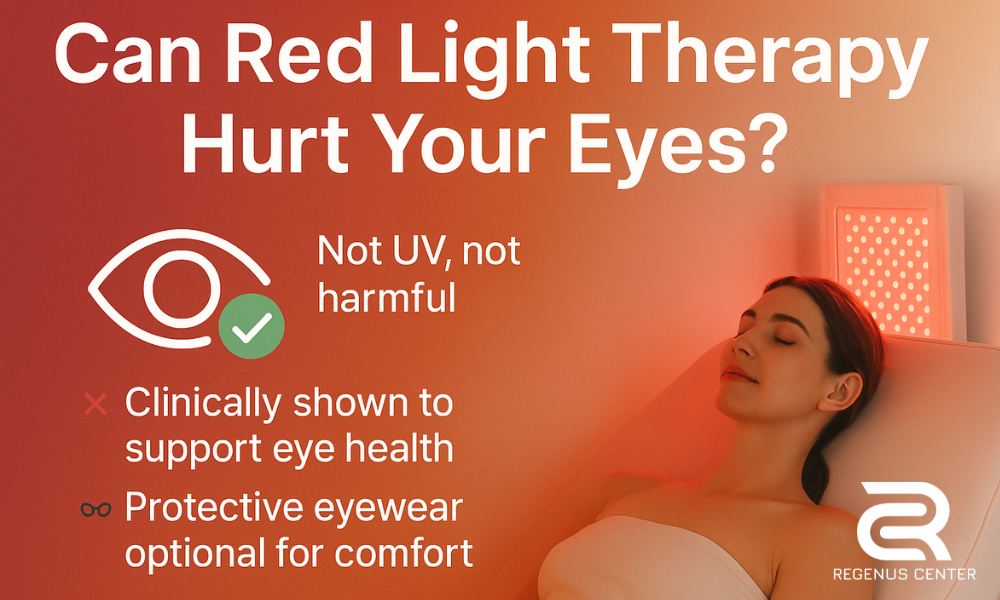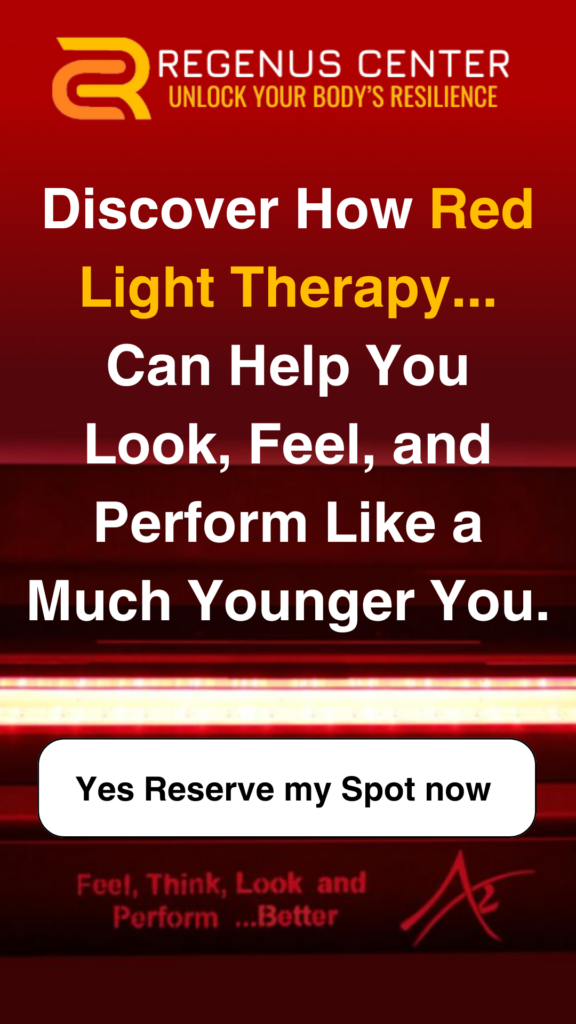If you’ve ever stretched out in one of our red light beds at Regenus Center, you may have had a passing thought: “This feels amazing for my body—but is it safe for my eyes?”?
It’s a smart question. We live in a world where we’ve been warned for decades about the risks of too much light—sunlight, UV rays, even blue light from screens. Therefore, it makes sense to pause and consider whether powerful red or infrared light could irritate or harm the eyes.
The reassuring answer?
When used properly, red and near-infrared light therapy are safe for your eyes—and in many cases, they may actually help protect and restore vision.
Why Light Safety Matters
Different kinds of light interact with the eye in different ways:
-
Ultraviolet light (100–400 nm): High-energy, ionizing wavelengths that can burn the cornea, damage DNA, and contribute to cataracts or macular degeneration.
-
Blue light (400–500 nm): Not as dangerous as UV, but linked with retinal stress and digital eye strain when exposure is excessive.
-
Red & Near-Infrared (600–1000 nm): Non-ionizing wavelengths used in photobiomodulation (PBM). These don’t break down DNA or proteins. Instead, they interact with mitochondria—the cell’s power plants—boosting energy production and supporting repair.
-
Far-Infrared (>1000 nm): Mostly felt as heat. Gentle in moderation (like in an infrared sauna), but prolonged high-heat exposure can dry the eyes or, in extreme occupational settings (glassblowing, welding), contribute to lens changes over many years.
What the Science Says
This isn’t just theory—scientists have directly studied the effects of red and near-infrared light on the eyes.
-
No evidence of harm at therapeutic levels. A review of PBM in BBA Clinical concluded that visible red and near-infrared light, at the doses used in wellness and medical applications, is considered safe for ocular tissues (Hamblin, 2016).
-
Vision support in aging. In Scientific Reports (2020), researchers found that just three minutes of daily 670nm red light improved declining vision in adults over 40 by recharging mitochondrial function in retinal cells.
-
Clinical use in macular degeneration. Trials published in Eye showed that red and near-infrared PBM led to improved visual function in patients with dry age-related macular degeneration—a condition typically marked by progressive vision loss (Merry et al., 2017).
-
Occupational exposure is a different story. Studies of glassworkers and others exposed to intense far-infrared heat (wavelengths >1000 nm) show that decades of chronic exposure may contribute to corneal stress or lens clouding (Sliney & Trokel, 1993). That’s heat-driven, not mitochondrial therapy.
So, Why Do Some People Feel Eye “Irritation”?
When clients ask about discomfort, it’s usually one of these simple factors:
-
Brightness: Strong LED panels can feel uncomfortable to look at directly, even if they’re not damaging. It’s similar to staring into a lamp. Protective goggles are provided mainly for comfort.
-
Dryness from heat: This is a sauna or far-infrared effect—not red light therapy. Heated air can dry the surface of the eyes, but PBM devices are non-thermal.
-
Individual sensitivity: Certain medications or medical conditions can increase sensitivity to light. In those cases, extra caution or eyewear is wise.
The Regenus Center Approach
At Regenus Center, we’ve built our recovery systems with both safety and efficacy in mind:
-
We use FDA-cleared, non-laser LED technology—powerful enough to stimulate change, but nowhere near the hazard levels of industrial lasers.
-
Our sessions are calibrated to deliver therapeutic doses backed by research.
-
Eyewear is optional but recommended for everyone, and we supply the goggles. Clients can use them for comfort, but it isn’t required for safety.
-
Most importantly, our focus is on creating a restorative experience—where light feels calming, not irritating.
Many of our clients actually notice the opposite of irritation: their eyes feel refreshed and relaxed after sessions. However, we tested it ourselves and found that, over time, regular use of infrared light can irritate.
Unless you are using red light therapy alone, where there is no limitation and you can even keep your eyelids open, we highly recommend using the goggles for about 2-3 minutes after getting into the light bed. We have learned from experience that it’s more engaging when you get at least a few minutes of eye contact directly with the light (with your eyelids shut).
Bottom Line
So, can red light therapy hurt your eyes?
Not when it’s used properly.
In fact, the weight of research suggests that it may be one of the simplest and most effective ways to support eye health—especially as we age.
The only real risks come from misuse of high-powered lasers or prolonged exposure to infrared light or overexposure to far-infrared heat, which is not part of the red light therapy photobiomodulation we provide.
That’s why we’re proud to say: at Regenus Center, your eyes—and the rest of you—are not just safe, they’re being renewed.
References
-
Hamblin, M.R. (2016). Shining a Light on the Head: Photobiomodulation for Brain Disorders. BBA Clinical, 6, 113–124.
-
Merry, G.F., et al. (2017). Photobiomodulation as a novel treatment for dry age-related macular degeneration: Results from the LIGHTSITE I trial. Eye, 31, 779–790.
-
Shinhmar, H., et al. (2020). Optically improved mitochondrial function in aged human retina: Near-infrared light boosts vision. Scientific Reports, 10, 14548.
-
Sliney, D.H., & Trokel, S. (1993). Medical Lasers and Their Safe Use. Springer.





